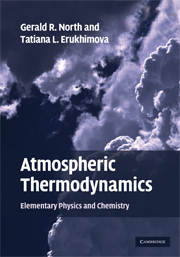Book contents
- Frontmatter
- Contents
- Preface
- 1 Introductory concepts
- 2 Gases
- 3 The First Law of Thermodynamics
- 4 The Second Law of Thermodynamics
- 5 Air and water
- 6 Profiles of the atmosphere
- 7 Thermodynamic charts
- 8 Thermochemistry
- 9 The thermodynamic equation
- Appendix A Units and numerical values of constants
- Appendix B Notation and abbreviations
- Appendix C Answers for selected problems
- Bibliography
- Index
5 - Air and water
Published online by Cambridge University Press: 01 February 2010
- Frontmatter
- Contents
- Preface
- 1 Introductory concepts
- 2 Gases
- 3 The First Law of Thermodynamics
- 4 The Second Law of Thermodynamics
- 5 Air and water
- 6 Profiles of the atmosphere
- 7 Thermodynamic charts
- 8 Thermochemistry
- 9 The thermodynamic equation
- Appendix A Units and numerical values of constants
- Appendix B Notation and abbreviations
- Appendix C Answers for selected problems
- Bibliography
- Index
Summary
In nature water presents itself in solid, liquid and gaseous phases. Energy transfers during transformations among these phases have important consequences in weather and climate. The system of redistribution of water on the planet constitutes the hydrological cycle which is central to weather and climate research and operations. Water is also an important solvent in the oceans, soils and in cloud droplets. The presence of tiny particles in the air can influence the formation of cloud drops and thereby change the Earth's radiation balance between absorbed and emitted and/or reflected radiation. These and other effects lead us into the fascinating role of water in the environment. Of course, thermodynamics is an indispensable tool in unraveling this very challenging puzzle.
Vapor pressure
We start with a discussion of the equilibrium gas pressure in a chamber in diathermal contact with a reservoir at a fixed temperature, T0. The chamber is to have a volume that is adjustable, as shown in Figure 5.1. In the following let the chamber have no air present – only the gas from evaporation of the liquid. We are to choose a volume V such that there is some liquid present at the bottom of the chamber (we say here the bottom of the chamber, but otherwise we ignore gravity). There are gas molecules constantly striking the liquid from above and sticking. […]
- Type
- Chapter
- Information
- Atmospheric ThermodynamicsElementary Physics and Chemistry, pp. 99 - 133Publisher: Cambridge University PressPrint publication year: 2009



